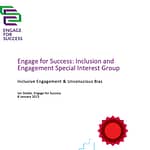18 months ago, a small group of people got together to discuss diversity & inclusion and employee engagement, as part of Engage for Success.
We didn’t know each other. We were very different in many ways. And we certainly didn’t always agree with each other. But we had a common cause.
Yesterday we hosted our first conference on Leading & Engaging a Diverse Workforce.
It featured some exceptional speakers.
David Macleod, co-founder of the Engage for Success movement. Natural storyteller.
Rachel Gray, Sales Director and Inclusion & Collaboration Lead, Cisco. Inspiring.
Plus Samantha Dawe (Madano) and Henry Davies (106 Communications) sharing insights.
And all brilliantly chaired by Sneha Khilay.
So what did we learn?
Fundamentally, “it’s all about attitude…”.
We can change all the processes in the world, but if the attitude (and therefore commitment) isn’t there, it will simply become compliance and a tick-box exercise.
D&I – The most successful organisations have senior sponsors and champions, who have the ‘attitude’.
Importance – Sounds simple, but it’s got to mean something to the business and, most of all, the people within it. We’ve always got to answer the question ‘why should I care?’. Will it make a difference to me or my team, to my customers or the performance of my business?
Terms of reference – Diversity and inclusion can feel like some ungodly HR programme, which ‘I just don’t have time for’. But if it’s about creating a level playing field for everyone or about driving sales results, what’s not to like?! The terms of reference need to be less about Diversity & Inclusion; more about the benefit to everyone.
Challenging the status quo – It takes a brave leader to go against ‘client feedback’, but that’s what one leader at IBM did. Some clients said they wanted to see more senior consultants (i.e. the typical image of a consultant). But the leader stuck to his guns and said we want to recruit a more diverse group of people that can ultimately give us greater benefit. They are starting to see the results now.
Measurement and disclosure – It’s hard to measure something if people don’t disclose their ethnicity, disability, sexuality and so on. But we did hear about an interesting concept from Cisco – ‘Team Space’. Colleagues are invited to ‘check in’ once a week to comment on how their week has been and provide any feedback, good or bad. Although not yet launched in the UK, over 36,000 people checked in between June and August; and it is apparent that simply checking in drives up engagement, regardless of whether you’ve had a good week or not so good week. Then, when a manager responds, engagement is doubled.
Outcomes – It’s difficult to pinpoint one specific action that translates into a change in colleague engagement, client satisfaction and business performance. It’s often about how a series of changes and actions impact on the organisation over a period of time. In this sense, we need to think long, rather than short, term. We were reminded of Paul Polman’s decision as CEO of Unilever to do away with quarterly reporting, because it is simply a ‘cult’ that reinforces short-term decision-making. We need to take the same approach to employee engagement.
Fundamentally, we are talking about an age of ‘personalised engagement’ where individuals are treated as such, with the respect they deserve, and given every opportunity to shape their own future as well as that of the organisation. We should not look at colleagues as a homogeny. Technology demands otherwise, and so too do colleagues. Most importantly, though, it is the benefit to customers and organisations that matters most. Personalised engagement delivers results.
Author: Henry Davies of 106 Communications




